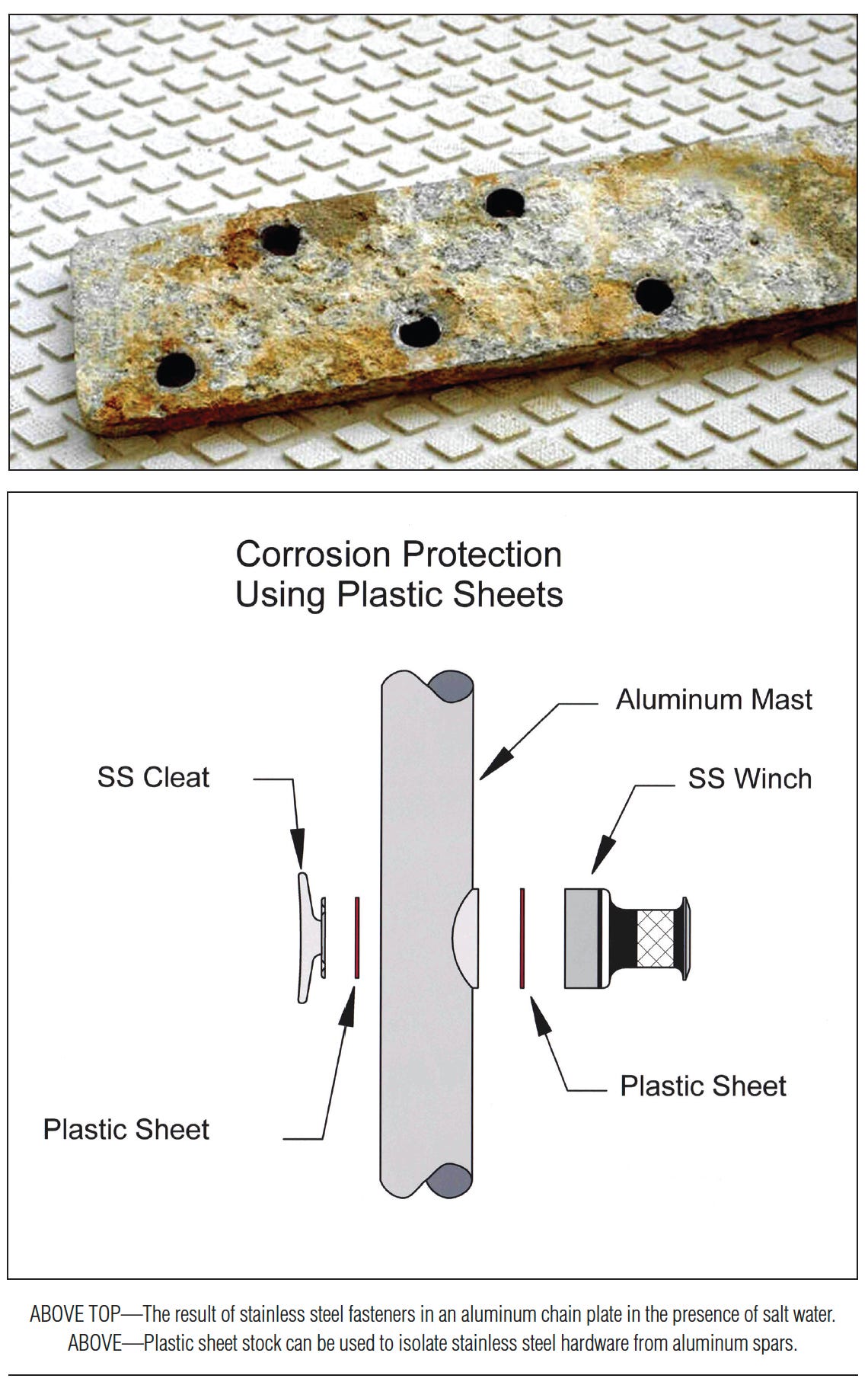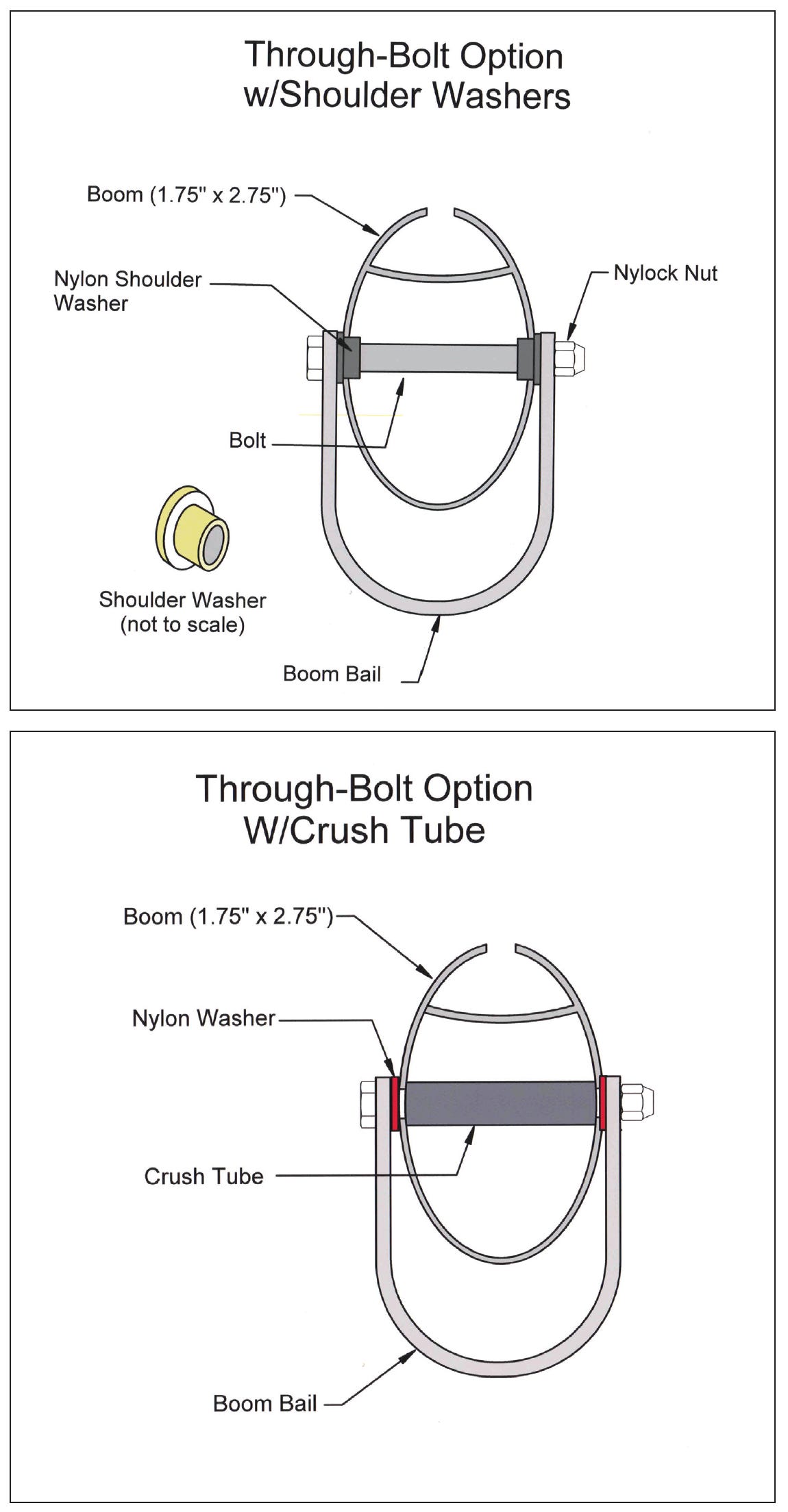We recently received the following email from Christine aboard Christine’s Dream, a Sparrow 16 sailed in Idaho:
Dear Capt’n Pauley (c/o SCA)
This spring in anticipation of the upcoming, albeit late, sailing season here in north Idaho I decided to examine my mast and boom to check the attachment of the tangs, vang bails, mast hound, etc. While doing my inspection I began to wonder what would be the best method of attaching these items to an aluminum spar. I have seen used pop-rivets (aluminum and stainless steel), sheet-metal screws, and machine bolts with nylon locking nuts.
Some of the questions that arose to which I realized I did not know the answer include; what are the advantages and disadvantages of each type? How would one choose the optimal attachment technique? How long can a nylon locking nut be expected to stay locked when exposed to the elements (or when protected from the elements)? When are locking washers appropriate to use? Any guidance you can provide me on this topic would be greatly appreciated.
Thanks!
Christine
Sparrow 16 #19
”Christine’s Dream”
This is a subject I’m often asked about and deserves a rather long answer.
First of all, I want to deal with the subject of lock washers. Most commonly, these are split washers with one end of the split raised above the other. The theory is that, under compression from the bolt, the washer will compress and the points of the split will dig into the surface being bolted to and so resist loosening. Current practice, from sources as disparate as NASA and BMW, is to not allow lock washers. If the washer should break, the joint will loosen up. In softer materials, such as aluminum, the lock washer will gall the surface and ultimately loosen. You can use them to make “industrial” looking necklaces or play Tiddlywinks with them. I just throw them into the trash.
Now down to serious work. The main problems with fastening anything to aluminum spars are galvanic corrosion and/or crushing. Corrosion is by far the most common problem. Aluminum in combination with just about any fastener material has the potential for corroding the aluminum. This process is vastly accelerated when the combination is exposed to salt water. In this instance, you have the advantage of sailing in fresh water, reducing the potential for corrosion.
One potential fastening solution is the use of pop rivets. These are commonly available in mild steel or aluminum with mild steel mandrels. Less common are all aluminum or stainless steel pop rivets. Regardless of mandrel type, aluminum pop rivets are made from very soft aluminum and can be subject to wear or breakage under stress. There are high strength aluminum pop rivets available, but these are designed for aircraft use and are hard to find and expensive. They are available from suppliers such as Wicks Aircraft Supply or Aircraft Spruce and Specialties. Typical prices are from $.35 to $.62 each. That compares to $5.28 per hundred for big box store rivets.
Two types of pop rivets are available in many materials; open end and closed end. The typical pop rivet you find in a big box store is open ended; the mandrel is usually retained but the rivet isn’t watertight. The mandrel can fall out, greatly reducing the shear strength of the rivet. Water can leak into the interior of the spar, increasing the possibilities of corrosion. Closed end pop rivets retain the mandrel which renders the rivet waterproof.
Big box store pop rivets can be “popped” using a cheap pliers-like tool. High end aluminum and stainless steel rivets may require a more powerful and costly tool. A good high-end tool will have a selection of nose bits for different sized rivets.
Some have suggested threading the aluminum mast and using a machine screw to fasten the fitting to the spar. Aluminum will need to be threaded with coarse threads to allow for maximum screw retention. By and large, aluminum spars are thin walled and are not really thick enough to support a decent number of threads, disallowing threaded fasteners.
More common is the use of stainless steel self-threading screws. Properly sized, they do have adequate holding power, as suggested by their wide-spread use.
Through-bolting is another solution for situations requiring high strength. This process works well when combine with Nylock nuts. Nylock nuts have a nylon insert that deforms when the nut is applied and resists loosening. They don’t require that they be heavily torqued to maintain the anti-loosening action. In fact, the nut can be positioned anywhere on the bolt threads and maintain that position. This eliminates the possibility of crushing the spar.
Another solution to the crushing problem is the use of a crush tube. The crush tube is placed between the walls of the spar and the bolt and nut tightened against it. This solution only works if you have access to the interior of the spar to install the tube. Mast head maybe, mast tangs, no way.
One situation to be aware of is the galling of stainless steel nuts on stainless steel fasteners. Under some conditions, the nut will weld itself to the bolt to the point where the bolt will break before the nut turns. A light coat of a never seize compound will cure this situation. Make sure you use a marine grade compound as automotive never seize contains copper, death to any sort of aluminum (never drop a penny in the bottom of an aluminum boat!).
As far as I’m aware, there is little or no environmental impact on the nylon part of the Nylock. I have Nylock’s that have been installed on Ternabout since 1972 with no signs of degradation. That being said, I never reuse a Nylock. Once the nylon insert has been deformed, I worry about the ability of the nut to stay tight. Since I am a belt and suspenders type of guy, I pitch the old Nylock and install a new one. Cheap insurance.
Regardless of what type of fastener you use, you will still be fastening a stainless steel fitting to an aluminum spar with all the potential corrosion issues. The problem is to mitigate, as far as possible, the consequences of galvanic corrosion.
One solution is to isolate the stainless steel fastener from the aluminum spar using nylon washers. They are available in a wide variety of sizes, in flat and shouldered types. They are strong enough not to deform under load.
When using the more common self-threading stainless steel screws, the washer solution often doesn’t work as the threads are still in contact with the aluminum. In these cases, a thread coating is used. One such coating is Ultra Tef-Gel. It is both a thread lubricant and anti-corrosion coating. It is a PTFE paste that is liberally applied to the threads when attaching the fitting to the spar. Both Forespar and Star-Brite offer similar products. Forespar also offers a lanolin based product for use as a long term corrosion inhibitor. When using self-tapping screws, mount the hardware, then unscrew the screw and coat the threads before reinstalling.
When installing larger stainless steel items, such as winches, another solution is to place a sheet of plastic between the hardware and the spar. Some people have cut sections from milk bottles for this use. Another source of thin plastic sheets is your local hobby shop. Many carry small sheets of white, black or clear styrene. Common sizes are 6" x 12", 11" x 14" and 12" x 24". Prices range from $3.90 to $41.70 depending on size, color and thickness.
My preferences? Through-bolt where possible, otherwise self-tapping stainless steel sheet metal screws. All applied with as much anti-corrosion mitigation as I can muster. •SCA•
First appeared in issue #89





Well timed for some fall projects I am planning. If one does use stainless rivets, what is the best way to protect against corrosion? Use of the same products mentioned under stainless screws?
Good, thorough article. Thanks